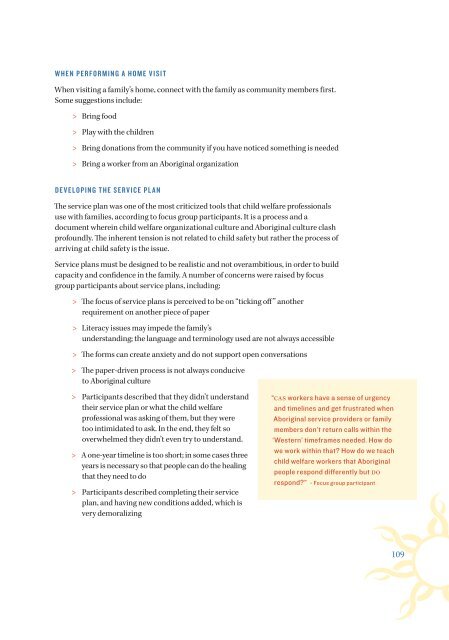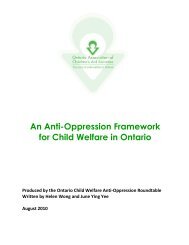English - Ontario Association of Children's Aid Societies
English - Ontario Association of Children's Aid Societies
English - Ontario Association of Children's Aid Societies
Create successful ePaper yourself
Turn your PDF publications into a flip-book with our unique Google optimized e-Paper software.
WHEN PERFORMING A HOME VISIT<br />
When visiting a family’s home, connect with the family as community members first.<br />
Some suggestions include:<br />
> > Bring food<br />
> > Play with the children<br />
> > Bring donations from the community if you have noticed something is needed<br />
> > Bring a worker from an Aboriginal organization<br />
DEVELOPING THE SERVICE PLAN<br />
The service plan was one <strong>of</strong> the most criticized tools that child welfare pr<strong>of</strong>essionals<br />
use with families, according to focus group participants. It is a process and a<br />
document wherein child welfare organizational culture and Aboriginal culture clash<br />
pr<strong>of</strong>oundly. The inherent tension is not related to child safety but rather the process <strong>of</strong><br />
arriving at child safety is the issue.<br />
Service plans must be designed to be realistic and not overambitious, in order to build<br />
capacity and confidence in the family. A number <strong>of</strong> concerns were raised by focus<br />
group participants about service plans, including:<br />
> > The focus <strong>of</strong> service plans is perceived to be on “ticking <strong>of</strong>f ” another<br />
requirement on another piece <strong>of</strong> paper<br />
> > Literacy issues may impede the family’s<br />
understanding; the language and terminology used are not always accessible<br />
> > The forms can create anxiety and do not support open conversations<br />
> > The paper-driven process is not always conducive<br />
to Aboriginal culture<br />
> > Participants described that they didn’t understand<br />
their service plan or what the child welfare<br />
pr<strong>of</strong>essional was asking <strong>of</strong> them, but they were<br />
too intimidated to ask. In the end, they felt so<br />
overwhelmed they didn’t even try to understand.<br />
> > A one-year timeline is too short; in some cases three<br />
years is necessary so that people can do the healing<br />
that they need to do<br />
> > Participants described completing their service<br />
plan, and having new conditions added, which is<br />
very demoralizing<br />
“CAS workers have a sense <strong>of</strong> urgency<br />
and timelines and get frustrated when<br />
Aboriginal service providers or family<br />
members don’t return calls within the<br />
‘Western’ timeframes needed. How do<br />
we work within that How do we teach<br />
child welfare workers that Aboriginal<br />
people respond differently but DO<br />
respond” - Focus group participant<br />
109

















